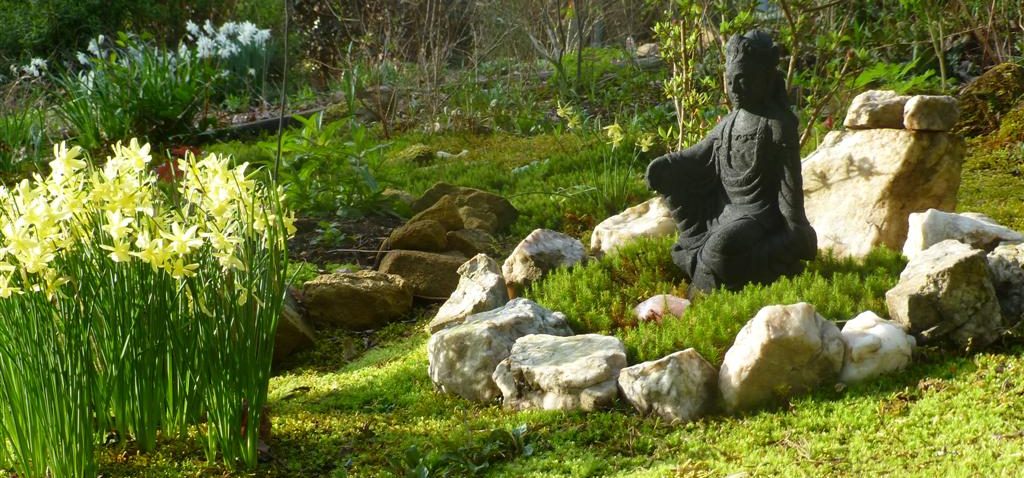The moss garden is a place of healing. If I’m tired and do some moss-weeding I feel rejuvenated. I call it “bending to the green” and feel like I’m bathing in green endorphins. Lying on the soft bed of moss creates a deep sense of rest. Walking on it barefoot, you can feel the verdant energies rise up through the soles of delighted feet. The green glow emanating all around you provides a sense of compassionate presence. The moss garden thrives in every season. In spring the dappled sunlight on the moss makes the air itself radiate greenness. It is indeed a “green room.” All summer, the expanse of luminous green soothes the eyes. In winter it is an oasis of intense color ranging from light chartreuse to deep veridian, and little moss plants sticking up through the snow are a sweet sight. Peering through a magnifying glass, a whole intricate miniature world emerges to stimulate the imagination. The broad expanse of moss is like a canvas, inspiring ideas for constantly changing combinations of rocks, wildflowers, ferns, and moss. Our friends love to have tea in the moss garden; it’s an outdoor teahouse with a beautiful view.
The broad carpet of moss in our garden is a constantly evolving mixture of Mnium, Plagiomnium, Bryoandersonia, and Entodon. Polytrichum and Hypnum, though, and Atrichum where it is happy, are so dense they grow alone in lovely patches. “Mnium” is the ancient Greek word for moss. Because the genus names of so many of the mosses in our garden end in “um,” Polytrichum, Aulacomium, Climacium, Dicranum, Thuidium, Leucobryum, Hypnum, I call them collectively “The Ums.”
The enclosed moss garden is a sacred place, a temenos, for earth-honoring ceremonies. In the east, for the element of Air, is a small rock altar with a hanging chime, ribbons that blow in the wind, a basalt cobble with a place to hold incense. In the south, pointed rocks and a torch for Fire. In the west, a birdbath into which fingers can be dipped to purify, to honor Water. In the north is a rock and moss (Atrichum and Dicranum) shrine to Mother Earth at which to kneel. There is also a spiral of milky quartz and Leucobryum to celebrate that beautiful combination so often found together in the wild. In the center of the garden is a little moss-roofed spirit house attached to a large male persimmon tree to honor the nature spirits. It seems fitting that Japanese temples to the Spirits are surrounded by moss gardens.
If you want to begin a moss garden I would recommend looking around your property to see if there are mosses already growing somewhere. If so, that means they like the growing conditions, and that’s a good place to start tending them and letting them expand. Plant rescues from land that is being developed are good opportunities to bring in some other species. My favorite books on mosses and moss gardening are Annie Martins’ The Magical World of Moss Gardening; George Schenk’s Moss Gardening; and, for a perspective that bridges between scientific and sacred ways of knowing, there is Gathering Moss, by Robin Wall Kimmerer, a Native American biologist.
Text and photo © 2017 Betty Lou Chaika

Leave a Reply